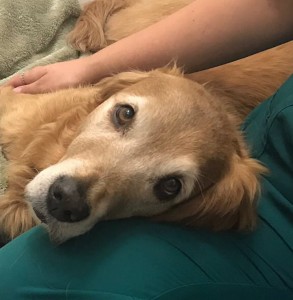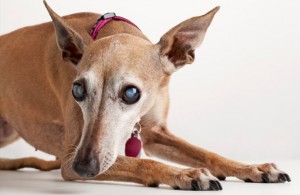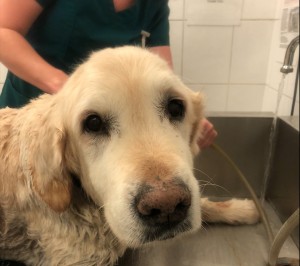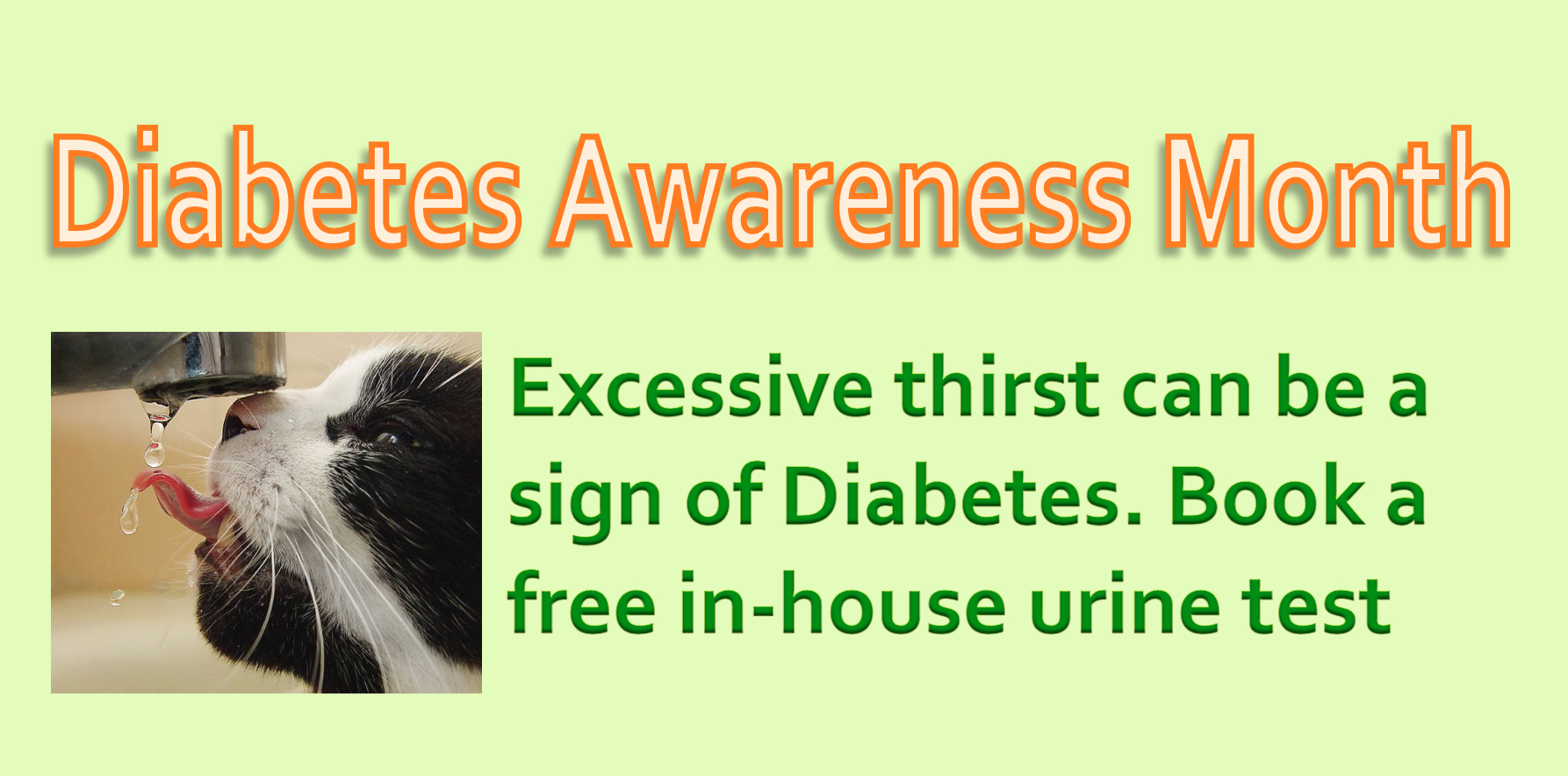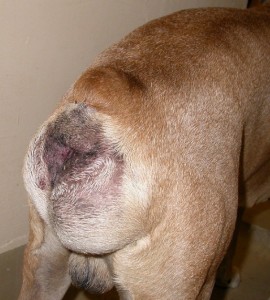News
Pet of the month – December – Barry
by admin on December 3rd, 2018
Category: Pet of the Month, Tags:
We are delighted to report that he has responded well to treatment but unfortunately we have been unable to locate Barry’s owner. Fingers crossed!
Cataract Surgery
by admin on November 1st, 2018
Category: News, Tags:
A cataract is an opacity or clouding in the lens in the eye. The opacity normally makes the lens look white. The lens in the eye is like the lens in a camera except that, rather than being at the front as it is in a camera, the lens in the eye is deep inside it, just behind the coloured part of the eye (the iris). The lens shows up as black in the central part of the eye (the pupil). The lens is normally crystal clear but it looks black because the darkness inside the eye shows through it. The lens is there to focus light on the sensitive tissue at the back of the eye (the retina).
Cataracts often form in both eyes and they frequently get worse. One eye is often more affected than the other, at least initially. It is not known why most cataracts develop. They are most common in older dogs and sometimes they occur due to other problems such as diabetes or disease in the back of the eye (the retina). Some cataracts are inherited.
What treatment is there for cataracts?
At the moment the only treatment for cataracts is surgery. Unfortunately not every cataract is suitable for surgical treatment, and it is necessary for the eye specialist to assess each patient and decide what therapy might be possible. Some cataracts are more complicated to treat than others, and the specialist will give guidance depending upon the circumstances in each case.
When is the best time to operate on a cataract?
The previous belief that it is best to let a cataract ‘ripen’ and the eye to become totally blind before removing the opaque lens (the cataract) has been proven wrong. Any cataract that is developing will cause potentially damaging inflammation in the eye due to release of lens proteins – a condition called ‘lens-induced uveitis’. Lens-induced uveitis can be subtle and easily missed – or, in some cases, it can be severe and associated with an obviously sore and inflamed eye.
Left untreated, even low levels of lens-induced uveitis are likely to result in complications, including adhesions (sticking) between the iris and the lens, retinal detachment (where the light-sensitive tissue at the back of the eye comes away from the back of the eye and stops working) and glaucoma (increased pressure in the eye which is potentially blinding and painful). Many eyes with long-standing cataracts that have not been operated on will eventually become irreparably blind and painful, and have to be removed as a result of the effects of lens-induced uveitis.
Early cataract surgery is therefore recommended in order to avoid the detrimental effects of lens-induced uveitis, and in general surgery is carried out once a cataract starts to interfere significantly with vision. This especially applies to young and diabetic patients, where progression of cataracts can often be rapid and result in significant complications if treatment is delayed. We will endeavour to see such patients at short notice and we will also often advise the referring veterinary surgeon to start treatment with topical anti-inflammatory drugs to manage lens-induced uveitis prior to us seeing the patient.
Cataracts in older dogs or patients with very slowly progressive cataracts may be monitored, but we will often recommend the prophylactic use of anti-inflammatory drugs in such cases.
The surgery
Your dog will usually be admitted on the morning of the surgery and no breakfast should be given. Water should not be withheld overnight. Diabetic patients need special management, and this should be discussed with the vet involved. After the patient is admitted, drops are given every 15 minutes prior to surgery to prepare the eye for the operation. These drops help to dilate the pupil and reduce the effects of inflammation which always happens in dogs having cataract surgery.
Before surgery all patients have an ultrasound scan to check for problems such as retinal detachment or rupture (bursting) of the lens. These changes are more common in advanced cases. The scan is performed under sedation. Some patients may be found to be unsuitable for surgery when the ultrasound scan is carried out.
Cataract surgery is performed under a full general anaesthetic and a muscle relaxant is given so that the eye comes into the correct position for the operation. This means that a ventilator needs to be used to inflate the chest during the procedure. We monitor your dog very carefully throughout the surgery using very modern sensitive equipment and the staff involved are specially trained in the procedure. This helps to reduce the risks of the anaesthetic to a very low level.
The operation is very delicate and involves the use of an operating microscope and tiny instruments. Two small cuts are made in the window of the eye (the cornea), near where the coloured part (the iris) joins the white part.
The lens is just behind the iris and lies in a delicate bag of tissue called the capsule. After the eye has been filled with a special gel called a viscoelastic, some of the lens capsule is taken out. The gel which is used helps to inflate the eye and protect the structures inside it from the effects of the surgery, and especially from the instruments and the ultrasound. The cataract (in other words, the lens) is then removed through the hole in the capsule using a technique called phacoemulsification – this is an ultrasound procedure using very sophisticated equipment which is exactly the same as that which would be used on a human eye. This type of surgery has been shown to give the best results in dogs’ and humans’ cataracts. There is currently no laser treatment for cataracts in dogs or humans.
In most patients it is possible to put in a special artificial lens where the old lens was. Plastic lenses make vision in the eye similar to the way it used to be before the cataract developed. The lenses used in our patients are made especially for dogs as they are bigger and more powerful than human lenses. They are permanent and buried deep inside the eye. The complication rate of lenses is very low indeed. For technical reasons it is not possible to implant an artificial lens in some eyes. Not having a lens implanted does not make the difference between being blind and having sight – it is similar to someone who wears glasses not putting them on.
At the end of the surgery the wounds in the eye are closed with tiny dissolving stitches. These are absorbed over the next few weeks, leaving only very small scars.
Some dogs can have both eyes operated on at the same time. The main reason for doing this is that it makes it more likely that the patient will have vision after the surgery – if something goes wrong with one eye, hopefully it will not also go wrong in the other one. However, a dog with one good eye will have overall vision which is almost as good as that in a dog with two good eyes, and so it is not essential to have both eyes operated on.
Most patients stay in overnight after their operation and are discharged the following day, provided that progress is satisfactory. Most dogs can see something on the day after surgery, but it frequently takes a few weeks for vision to settle down as the eye adjusts to the effect of surgery and the presence of a plastic lens implant. In addition, there is often some clouding inside the eye which takes time to clear.
Aftercare
The aftercare following cataract surgery is intensive. All patients develop inflammation inside their eyes after surgery. This happens more in dogs than in humans. Usually there are several types of drops used. The most frequently applied drops are used six times daily initially. The number of applications gradually decreases over the next two months or so. There are also tablets to be given for a few weeks after the surgery.
Your dog will need to be kept as quiet as possible for a few weeks after the surgery, although this can obviously be difficult with many of our patients! You can only do your best in this regard. Pulling on a lead should be avoided for several weeks after surgery, as this puts up the pressure inside the eye and can encourage bleeding. Avoiding pulling around the neck is best achieved by using a harness, and it is a good idea to obtain one before the operation – it can be fitted at the time that your dog goes home. A plastic Elizabethan collar also has to be worn for about a week after the operation.
There will need to be at least four or five re-examinations after surgery. These are mostly within the first two to three months after the operation. Some patients, especially those with complicated cataracts, may need longer term treatment and more check-ups than average.
Risks and complications
The success rate of cataract surgery in dogs is about 90 to 95% initially. This means that 5 to 10% of patients cannot see in the operated eye after surgery. There are various reasons why not all patients have a successful outcome or may have a less straightforward recovery than normal. These include:
Inflammation
Every patient gets inflammation after surgery, no matter how smoothly the surgery goes. This is usually well controlled by the medications which are given. The occasional dog gets more inflammation than average, and this can lead to changes in the eye. These may not be of any great significance, but sometimes they can cause reduced vision.
Occasionally an injection into the eye is needed to dissolve inflammatory clot material. Inflammation is the main problem in dogs after surgery, and is the major reason why frequent medications and regular post-operative check-ups are required.
Infection
This can be very serious, but is extremely rare. Antibiotics in the form of tablets and ointment are used before and after the surgery to help to prevent this.
Wound breakdown
This means that the wound gives way. Again this is an uncommon complication, but if it occurs another general anaesthetic will be required to re-stitch the wound.
Bleeding
A very small amount of bleeding at the time of surgery is not unusual and this is not a major problem. Very occasionally a larger haemorrhage can develop and this can affect vision.
Increased pressure
The pressure in the eye can occasionally go up in the first few days after surgery, but eye drops will usually settle this down very quickly. Rarely a more severe increase in pressure may develop (glaucoma). If this problem develops it will involve additional medication and possibly surgery. It can lead to blindness and even loss of the eye in severe cases which don’t respond to treatment.
Ulcers
Occasionally the surface layer of the window at the front of the eye (the cornea) can partly come away after surgery. This is usually a very minor problem which normally resolves within about a week.
Corneal oedema (water-logging)
The window at the front of the eye (the cornea) can very occasionally go blue after surgery due to disturbance of its inner layer. Careful surgery and the use of viscoelastic gel (as previously mentioned) help to reduce the chances of oedema developing.
Retinal detachment
This is an uncommon complication, but if the sensitive tissue at the back of the eye detaches it can lead to loss of sight. A routine ultrasound scan before the surgery helps to identify at-risk patients.
Poor vision
Some dogs have problems inside their eyes (for example with their retina) which cannot always be detected before the surgery, and this may then mean that the surgery is not successful, or that the vision given by the surgery is not as good as it once was. Some suspect cases may have an electrical test (an electroretinogram) performed on the eyes to look for retinal problems before surgery, but this may well require sedation or even general anaesthesia and is not necessary or recommended for every case.
‘After-cataract’
A small percentage of dogs that see well immediately after their surgery may not continue to do so for the rest of their lives. This later deterioration may happen for many reasons (such as some of the complications mentioned). However, one such problem is known as after-cataract, in which a white membrane can grow across the pupil inside the eye. In most patients the amount of after-cataract which forms is not significant, but it can very occasionally affect vision in the long-term. Having a plastic lens implant has been shown to help to prevent the membrane growing across the pupil.
If after-cataract becomes very severe it can be removed surgically, although this is very rarely necessary.
Conclusion
The success rate of cataract surgery in dogs is high, and the great majority of patients do very well after their operation. It is undoubtedly a major undertaking, but the procedure is one which is commonly performed.
Pet of the month – November – Kim
by admin on November 1st, 2018
Category: Pet of the Month, Tags:
Pet of the month for November is Kim, a 14 year old Golden Retriever, seen here having her weekly bath. Kim has suffered from an underactive thyroid for some years and despite longterm supplementation with thyroid hormone still suffers from a flaky skin, which is a common symptom. Other than that the condition is being well managed.
What is hypothyroidism?
Hypothyroidism develops when the thyroid gland function falls below normal. In dogs and cats the two thyroid gland lobes lie on either side of the windpipe and produce thyroid hormone. This hormone controls the speed at which the body’s metabolism works. In patients with hypothyroidism, not enough of the hormone is produced. As a result the metabolism ‘slows down’, and, with time, this can affect almost all the organs of the body.
Hypothyroidism is common in adult dogs, but is very rare in cats.
How do animals get hypothyroidism?
In the majority of cases hypothyroidism is diagnosed in adult dogs that have previously been healthy. In most dogs the disease either develops due to the affected animal’s own immune system attacking the thyroid gland (‘lymphocytic thyroiditis’) or due to degeneration of the gland tissue. It is possible that both forms of the condition may in fact represent the same disease process. Over time, more and more thyroid tissue is destroyed until the gland cannot function any longer.
It is still not known why dogs develop this disease. Certain breeds of dogs are more susceptible to hypothyroidism – these include Retriever breeds, Doberman Pinscher, Setters, Terrier breeds and Spaniels (especially Cocker Spaniels). Hypothyroidism is rare in toy and miniature breeds. Several factors have been proposed that could trigger the immune reaction, but so far nothing has been proven.
Hypothyroidism is extremely rare in cats, but can very occasionally be seen after zealous treatment of an overactive thyroid gland.
In rare cases puppies and kittens are born without a functioning thyroid gland.
What are the clinical signs of hypothyroidism?
As the disease affects the whole metabolism, clinical signs are often vague and non-specific and can affect almost every aspect of the dog’s body. The disease can also mimic many other problems.
Many dogs are presented with weight gain and lethargy or lack of interest in activities they previously enjoyed. However, the majority of dogs presented because of weight gain are simply overweight because they eat too much (See Nutrition advice for dogs information sheet).
Often a ‘tragic expression’ of the face is noticed by owners of dogs with hypothyroidism, and this is due to thickening of the skin and loss of tone of facial muscles. A dull coat, greasy or darkened skin and hair loss, especially on the sides of the body and the tail, are also frequently noticed. Constipation can develop, although diarrhoea is also a possible problem because the immune system is less effective. This reduction in immunity can also lead to other infections such as chronic skin or ear problems. Less commonly, more severe clinical signs can be seen, such as those related to nerve function problems.
Hypothyroidism is not usually fatal, but it can compromise an affected dog’s quality of life.
Puppies and kittens born without a functioning thyroid gland do not grow properly and their mental development may be affected. Many of these patients do not survive, and those which do often suffer from chronic arthritis because of abnormal joint development.
Adult cats with hypothyroidism show similar signs to dogs, but such cases have only very rarely been reported.
How is the disease diagnosed?
Hypothyroidism is diagnosed by blood testing – the amount of thyroid hormone in the blood as well as the amount of TSH (a hormone that controls the function of the thyroid gland) is measured. However, further blood values are also looked at in order to test for other diseases, because the clinical signs of thyroid disease are not usually very specific. Depending on the individual case it may also be necessary to analyse a urine sample or even to perform further tests such as radiography (X-rays) or ultrasound examination.
If other diseases can be ruled out and the blood values show low thyroid hormone, then a diagnosis of hypothyroidism can be straightforward. However, not all blood tests results lead to a clear-cut diagnosis as thyroid hormone measurement can be influenced by a variety of other factors. In such cases it may be necessary to perform further blood tests, or in some cases to re-test after several weeks or months to confirm the disease. In some cases the diagnosis of hypothyroidism can be quite problematic.
Can hypothyroidism be treated?
Once hypothyroidism has been diagnosed, it can be readily treated with tablets containing thyroid hormone. The condition can be controlled rather than cured, and life-long medication has to be given to provide the body with thyroid hormone. As the required dose can change over time, repeat blood tests are necessary at intervals to check the level of hormone in the blood.
The clinical signs of hypothyroidism will improve with treatment but it can take several months for all the signs to resolve.
My pet has hypothyroidism, what is the outlook?
Once a pet is stabilised on medication, it will not be noticeable to anyone – including the animal – that he or she actually has a chronic disease. Pets with hypothyroidism that are on therapy have an excellent prognosis and can expect to live a normal life, as long as they receive medication and are properly managed with the help of your veterinary surgeon.
Feline leukaemia virus (FeLV) and Feline immunodeficiency virus (FIV)
by admin on October 1st, 2018
Category: News, Tags:
What are FeLV and FIV?
Feline leukaemia virus (FeLV) and feline immunodeficiency virus (FIV) both belong to the same group of viruses, the retrovirus group. This means they are somewhat related to one another and act in a similar way. Retroviruses such as FeLV and FIV are particularly successful because the immune system usually fails to remove them completely (unlike many other viruses), so affected cats become infected for life. Feline immunodeficiency virus (FIV) is related to the human immunodeficiency virus (HIV), but humans and cats cannot infect each other with their respective viruses.
How do cats get FeLV or FIV?
Cats can get FeLV and FIV through contact with other cats.
Feline leukaemia virus is usually transmitted through saliva, most commonly by friendly, social cats who like mutual grooming and do not mind sharing food bowls. However, FeLV can also be transmitted through bites.
Feline immunodeficiency virus is usually transmitted through biting by an infected cat, so individuals with FIV are typically entire tom cats or any other cats that like fighting.
What are the clinical signs of FeLV and FIV?
Both FeLV and FIV cause similar problems by gradually weakening the immune system. The protection this system normally gives against invading bacteria, viruses, fungi or parasites functions less and less well, and infected cats become prone to infections that a healthy immune system would often just fight off. As the immune system also helps to protect the body against cancer, infected cats in advanced stages of the disease have a much higher chance of developing a cancerous disease. Anaemia is another common problem, particularly in cats with FeLV. Despite its name, feline leukaemia virus does not necessarily cause leukaemia – it can do so, but it also causes a multitude of other diseases.
When an infected cat becomes ill, the clinical signs seen are usually due to the secondary infection or the cancerous disease which develops, rather than the underlying FeLV or FIV infection. This means that there are no typical clinical signs for either disease. Vets usually become suspicious when cats are presented either with persisting infections which they should be able to fight off, or with ‘non-standard’ disease, or with several concurrent infectious problems, or if the response to treatment is not as expected.
How and when is the disease diagnosed?
There are two possible situations in which tests are carried out for either FeLV or FIV.
- FeLV or FIV is suspected as an underlying disease
- A healthy cat is tested for FeLV and FIV to ensure that he or she is not carrying the virus already. This may be advisable before a newly adopted cat is introduced into the household, before breeding is attempted or before the first FeLV vaccination is given.
Whatever the reason for testing a particular cat, it is usually possible to diagnose FeLV and FIV with a blood test that can be done at the surgery. However, in some cases we may suggest sending a blood sample to a laboratory for more advanced testing methods to be used.
Can FeLV or FIV be treated?
Cats carrying FeLV and FIV virus cannot be cured. Both viruses cannot be destroyed by medication – this is similar to the situation in people with HIV. In human medicine, advanced anti-viral drugs are now available – these can effectively suppress the activity of the virus for long periods of time. Few of these (very costly) drugs have been used in cats and it is not really known whether such drugs are effective for FeLV/FIV or safe for cats to take. This means that there is currently no recommended specific treatment against either FeLV or FIV.
As the majority of clinical signs caused by both FeLV and FIV are due to a non-functioning immune system, it is often possible to treat any secondary infections or problems, thereby giving the patient a reasonable quality of life for a longer period of time. However, it must be remembered that the infected individual is a danger to the rest of the cat population and will spread FeLV or FIV unless he or she is kept isolated from other cats.
Can FeLV or FIV be prevented?
Whilst FeLV cannot be treated once a cat carries the disease, it is possible to prevent infection by vaccination. FeLV vaccination is advisable for all cats that can go out or have contact with cats that go out. Only cats that are kept indoors and have no contact with other cats do not need FeLV vaccination.
Unfortunately there is no FIV vaccine which is licensed for use in the UK, so prevention is much more difficult than it is for FeLV. Any cat that is not kept indoors at all times is at risk of infection with FIV.
My cat has tested positive for FeLV or FIV – what is the outlook?
This can depend very much on why your cat has been tested. If he or she was tested because of severe or recurrent illness and is positive for one or both diseases, this means that the disease is already present and the immune system is already compromised. Under these circumstances unfortunately the outlook may be poor. It may be possible to give your cat a reasonable quality of life for a period of time with medication and very good care. However, he or she will be shedding the virus and will therefore be a danger to other cats. If other cats live in the family, they should certainly be tested – even if they appear healthy – in order to find out whether they are already carrying the virus.
If your FeLV or FIV positive cat is otherwise healthy and was tested as a routine precaution, then the outlook depends very much on the particular circumstances. Depending on the individual animal, it may take months or even many years before the disease breaks out and the cat will seem healthy in the meantime. However, he or she will be able to pass on the virus to other cats. This means that your cat should be kept indoors and away from other cats. It is also advisable to ensure good health through regular vaccinations and worming, very good nutrition and dental care.
While some cats are happy to stay indoors and away from other cats – especially if someone in the family is at home at all times, too – others will not like being so confined, especially if they are used to an outdoor life. Should such a situation arise, we will discuss the options with you in detail and should you feel that you are able to give your cat a good quality of life we will also discuss special health-care issues to keep your cat happy and comfortable for as long as possible.
Pet of the month – October – Niamh
by admin on October 1st, 2018
Category: Pet of the Month, Tags:
Blood tests showed Niamh to have developed renal failure and because of the unique and unusual nature of the presentation she was referred to a specialist. Further diagnostic work indicated ‘acute on chronic’ kidney disease – very unusual in a five year old dog, as she was then.
Niamh has been the sweetest of patients with an extremely friendly, upbeat nature even when has been feeling very ill; despite the gravity of her illness she made great progress and was in remission until earlier this year when she started to deteriorate again. With appropriate treatment Niamh’s blood results have improved and we are hoping she may be back in remission again very soon.
Perineal Rupture
by admin on August 31st, 2018
Category: News, Tags:
What is a perineal rupture?
A perineal rupture (sometimes called a perineal hernia) is a weakness or separation of the muscles of the pelvic diaphragm. The pelvic diaphragm is formed from a group of muscles that are situated around the rectum and form the caudal (back) wall of the abdominal cavity.
A perineal rupture is an abnormal hole in this diaphragm or sheet of muscles that allows fat or organs from the abdominal cavity to bulge into the area surrounding the anus (the perineum).
What are the clinical signs?
Clinical signs can include:
- Perineal swelling – this can fluctuate in size
- Perineal bruising
- Pain/discomfort associated with the swelling
- Pain or discomfort when passing of faeces
- Constipation
- Urine retention – an inability to empty the bladder properly
- Acute illness due to obstruction of urine flow from the bladder
- Generalised malaise
What animals are affected?
The condition predominantly affects middle aged to older male dogs, particularly entire (uncastrated) males. However, younger male dogs, female dogs and cats can also be affected.
What are the causes?
There is a strong association between perineal rupture and the male hormone levels in middle aged to older entire male dogs. Any disease process that affects the levels of male hormones can therefore predispose to perineal rupture.
In addition, any condition that results in straining or increased intra-abdominal pressure can result in failure of the pelvic diaphragm muscles.
Risk factors for perineal rupture include:
- Entire (uncastrated) male status
- Disease of the testicles (e.g. tumours)
- Disease of the prostate gland, which is found near the neck of the bladder in male animals (e.g. benign enlargement, abscess, cysts, tumours)
- Straining due to abdominal disease (e.g. colitis [inflammation of the large intestine])
- Pregnancy (due to increased abdominal pressure)
What does investigation involve?
In order to maximise the chance of successful treatment of the rupture, it is important to identify risk factors that are present in the patient and treat these at the same time as treating the rupture. Each investigation is likely to be tailored specifically to the patient, although typically this may include the following:
- Rectal examination (which may require sedation or general anaesthesia) – this will include assessment of the side opposite to the obvious rupture
- Blood tests
- Urine analysis
- Ultrasound scan of the abdomen and possibly of the hernia
- Prostate gland investigation/biopsy
- Examination of the testicles
- Chest X-rays in some cases
Cases with displacement of the bladder can present as emergencies and require urgent stabilisation prior to investigation and treatment.
What treatment options are available?
Most cases will require repair of the rupture and this is combined with castration in entire males to reduce the risk of failure. Those cases with other disease processes that have contributed to the development of the rupture will need to receive treatment for that underlying problem, prior to or at the same time as repair of the rupture.
Some ruptures are repaired using the muscles that are present within the pelvic diaphragm, although many require movement of additional muscle into the area in order to close the rupture. In some severe cases, mobilisation of a muscle from a hind leg or a synthetic mesh may be required to complete the closure.
Further support for the repair can be given by fixing the bladder and colon (large intestine) into the abdomen but this is not necessary in all cases.
What is the prognosis (outlook)?
Over 90% of uncomplicated cases receiving rupture repair and castration resolve following the surgery.
In experienced hands, complications following surgery are infrequent, and animals usually stay in the hospital for a few days to ensure they are comfortable and passing faeces easily.
Despite careful selection of the technique used and meticulous care, complications can occur in a minority of cases and these include:
- Recurrence of the rupture – stool softeners may be advised long term to reduce the straining during defaecation and therefore protect the repair
- Rupture of the other side
- Infection (the surgical site is in the perineal region, near to the anus which is a source of bacteria)
- Faecal incontinence – this is uncommon and usually temporary
Pet of the month – September – Mawgan
by admin on August 31st, 2018
Category: Pet of the Month, Tags:
Pet of the Month for September is a delightful Golden Retriever called Mawgan, seen here recovering from surgery in the lap of one of our nurses.
He came in to the clinic for our August Offer which was designated Check-a-Lump Month and subsequently underwent surgery to remove 2 lumps from his feet.
We are pleased to report that Mawgan is recovering very well!
